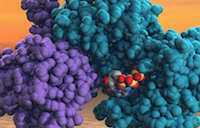The question arises often, what are enzymes? Enzymes within the diagnosis of diseases have shown an important role in biochemistry research since the 1940’s.
Many methods currently on record are not in wide use, and there are still large areas of medical research in which the diagnostic potential for chemical reactions to combat against diseases has not been explored.
This brief but informative section will hopefully answer the basics, while providing you with a strong foundation for understanding the principals behind your health needs and the relationship to enzymes.

Enzymes are found in every cell of every living plant and animal, including humans. Enzymes are biocatalysts; which means that they either begin a reaction or cause a reaction to speed up. Without enzymes life would not exist.
How do enzymes work?
Enzymes work by virtue of their shape. An enzyme molecule can be compared, in shape at least, to many short strings of pearls (amino acids) strung together. This long string folds in on itself as certain sequences of amino acids (pearls) are more attracted to each other than to other sequences, thus giving the enzymes a specific shape.
At one point on the surface of this string of pearls there exists something, which looks like a keyhole. This is called the “active site” on the enzyme. When matched with its specific coenzyme (a vitamin, mineral, or trace element) this “lock” has the exact inverse contour of the “key” which is contained in the molecule of the enzyme’s “substrate” (the molecule that the enzyme wants to transform into a different molecule). When the substrate appears, it inserts the “key” into the “lock.” The molecular structure of the substrate is transformed into a different molecular structure and both enzyme and the newly transformed molecule go on their merry ways.
What are digestive enzymes?
They breaks down the proteins, fats and carbohydrates in food during the digestive process allowing the body to better utilize the food you eat.
What are proteolytic enzymes?
The digests protein. Some examples are protease, serrapeptase, bromelain, and papain.
What are lipase enzymes?
They digest fat.
What are amylase enzymes?
They digest carbohydrates.
What is systemic enzyme therapy?
Systemic enzyme therapy is utilizing enzyme supplementation to increase the enzymes throughout your body to assist in restoring the body to health
What else are they used for?
Enzymes are widely used in the food industry. They are also essential in the manufacture of beer.
Are they considered “anti-inflammatory drugs”?
Proteolytic Enzymes are considered anti-inflammatory agents.